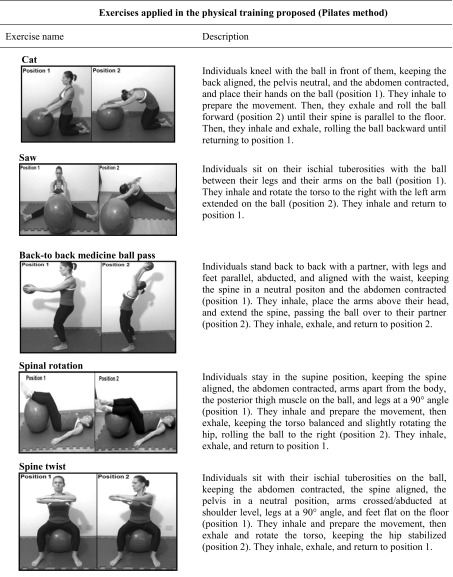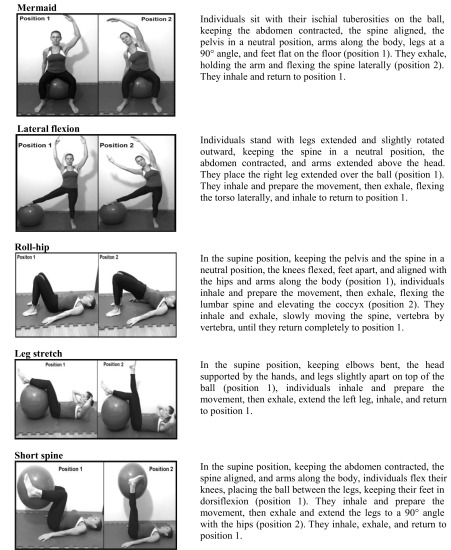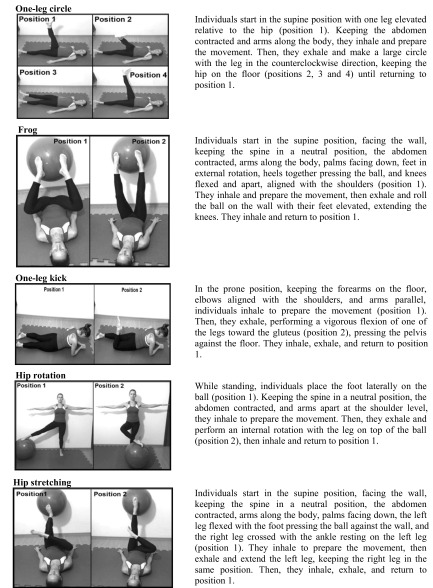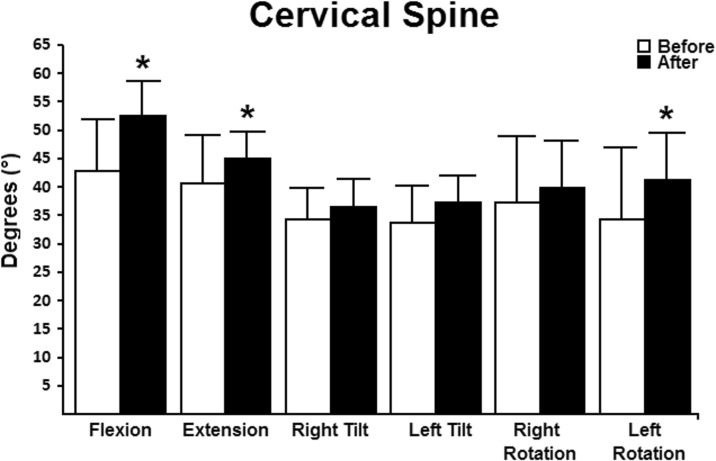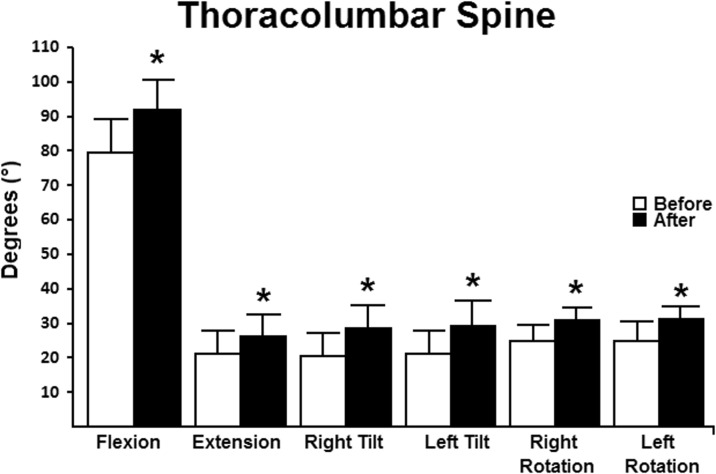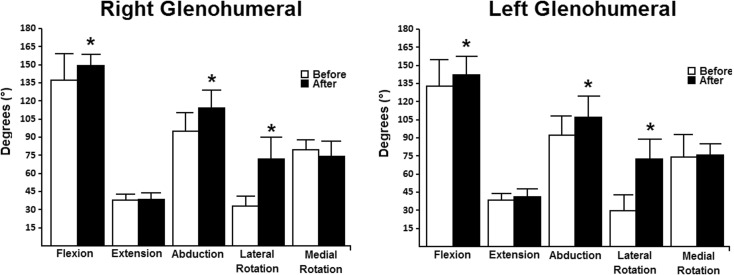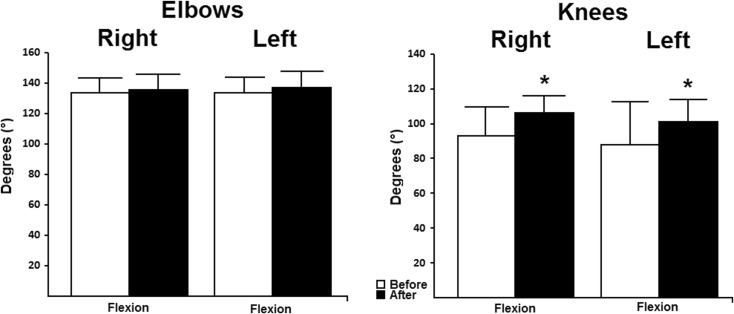Abstract
The adaptations of the human body resulting from the aging process especially loss of flexibility can increase the risk of falls and the risk of developing other health conditions. Exercise training, in particular the Pilates exercise method, has become an important form of physical activity that minimizes the deleterious effects of aging on flexibility. Few studies have evaluated the effect of this training method on body flexibility among elderly. We aimed to evaluate the effects of physical training using the Pilates method on body flexibility of elderly individuals. Eighteen elderly women and two elderly men (aged 70 ± 4 years) followed a 10-week Pilates training program. Individuals were recruited from the local community via open invitations. At study entry, none of them had limited mobility (walking requiring the use of walkers or canes). Furthermore, those with neurologic, muscular, or psychiatric disorders as well as those using an assistive device for ambulation were excluded secondary to limited participation. Flexibility assessment tests (flexion, extension, right and left tilt, and right and left rotation of the cervical and thoracolumbar spine; flexion, extension, abduction, and lateral and medial right and left rotation of the glenohumeral joint; flexion, extension, abduction, adduction, and lateral and medial rotation of the right and left hip; and flexion of the right and left knee) were performed by a blinded evaluator using a flexometer before and after the training period. All assessments were carried out at the same time of day. There was an observed increase in flexion (22.86 %; p < 0.001), extension (10.49 %; p < 0.036), and rotation to the left side (20.45 %; p < 0.019) of the cervical spine; flexion (16.45 %; p < 0.001), extension (23.74 %; p = 0.006), lateral bending right (39.52 %; p < 0.001) and left (38.02 %; p < 0.001), and right rotation (24.85 %; p < 0.001) and left (24.24 %; p < 0.001) of the thoracolumbar spine; flexion (right—8.80 %, p = 0.034; left—7.03 %, p = 0.050), abduction (right—20.69 %, p < 0.001; left—16.26 %, p = 0.005), and external rotation (right—116.07 % and left—143 %; p < 0.001 for both directions) of the glenohumeral joint; flexion (right—15.83 %, p = 0.050; left—9.55 %, p = 0.047) of the hips; and bending (right—14.20 %, p = 0.006; left—15.20 %, p = 0.017) the knees. The joint with the greatest magnitude of improvement was the thoracolumbar spine. Thus, this type of training may minimize the deleterious effects of aging and may improve the functionality of elderly individuals, which would reduce the likelihood of accidents (especially falls).
Keywords: Flexibility, Aging, Elderly individuals, Pilates method, Physical training
Introduction
During recent decades, the proportion of elderly individuals has increased globally. Evidence suggests that the global elderly population totaled approximately 800 million people in 2012, which represented 11 % of the population (USA 2013). Projections indicate that the number of elderly individuals will exceed 2 billion people by 2050, representing 22 % of the world’s population (USA 2013). According to the Brazilian Institute of Geography and Statistics (Instituto Brasileiro de Geografia e Estatística—IBGE), there will be approximately 30 million elderly individuals in Brazil by 2025, a number that corresponds to 10 % of the Brazilian population (IBGE 2009). This phenomenon should be accompanied by greater attention from society to elderly individuals (IBGE 2009; IBGE 2010). Such changes should include both preventive measures that can mitigate the physiological processes caused by aging and adequate treatment of specific diseases of this age group.
The aging process is characterized by natural wear of body systems, especially changes in the neuromuscular system, such as loss of sensory and motor neurons; loss of muscle mass (sarcopenia), especially type II fibers (Rosenberg 2011; Granacher et al. 2013); and decreased flexibility levels (Coelho et al. 2000). The main consequence of these changes is decreased functional capacity, which may increase the risk of falls, decrease the performance of activities of daily living, and reduce quality of life (Fabre et al. 2007; Vieira et al. 2013; Emilio et al. 2014). In addition to physical losses associated with aging, the elderly progressively reduce their levels of physical activity and become more sedentary, which may be associated with a decline in quality of life (Battaglia et al. 2014).
The American College of Sports Medicine recommends that health-related physical fitness should consider aerobic fitness, adequate body composition, muscular strength, and appropriate level of flexibility (ACSM 2011). Thus, trunk muscle strengthening is extremely important because these muscles provide stability and mobility to the individual and are thus essential to strength, muscular endurance, and level of flexibility of this region allowing to performing activities of daily living (Richardson et al. 1999; Kibler et al. 2006). In addition to muscle strengthening, maintaining the flexibility of the body is very important because it allows adequate joint movements to be performed, thus decreasing the risk of lesions (Spirduso et al. 1995).
Flexibility can be defined as the adequate physiological range of motion of a given joint (Holland et al. 2002) and has an essential role in the performance of simple or complex movements involved in activities of daily living. In addition to compromising the performance of everyday movements, decreased flexibility may result in musculoskeletal damage (Badley et al. 1984). With advancing age, the range of motion decreases, and according to Holland et al. (2002), depending on the joint, a loss of up to 50 % of flexibility can be observed (Holland et al. 2002). Some studies (Narici et al. 2003; Baroni et al. 2013a) have suggested that the muscle fiber length of elderly individuals is shorter compared to that of young individuals. Such muscle adaptation may be associated with decreased flexibility in elderly individuals, which results in reductions in mobility and the ability to walk (Narici et al. 2003), hindering the performance of their activities of daily living (Mota et al. 2006). Previous studies (Bassey et al. 1989; Fabre et al. 2007) have reported an association between quality of life or life satisfaction and upper body flexibility in older people.
Because the aging process causes several structural and functional changes, exercises aimed at muscle strengthening and/or increased flexibility in large joints are extremely important for the elderly population. Among the different types of physical training, the Pilates method has emerged as an option to reduce changes caused by the aging process. This method was developed by German national Joseph Pilates (1883–1967). Initially, Pilates was practiced by dancers, but it later spread to the general population. This method results from the combination of Eastern and Western techniques and involves several arts, such as philosophy, yoga, dance, and gymnastics and focuses on trunk strengthening to promote increased strength, flexibility, coordination, and balance (Johnson et al. 2006).
There are some articles about Pilates method exercises (Sekendiz et al. 2007; da Luz et al. 2014; Campos de Oliveira et al. 2015). However, to the best of our knowledge, very few articles aimed at evaluating the effect of this method on body flexibility among elderly individuals. Thus, considering the adhesion to the Pilates method is substantial and the need to have an appropriate level of flexibility to health-related physical fitness, the present study aims to evaluate the effects of physical training with the Pilates method on the body flexibility of elderly individuals. Based on the literature (Plachy et al. 2012; Bullo et al. 2015), we hypothesize that a Pilates training program can improve body flexibility in elderly individuals.
Materials and methods
This study adopted a single-group, repeated-measures (before and after 10-week exercise program) design. Twenty-five elderly individuals (22 females and 3 males), with a mean age of 69 ± 5 years, were included in the study. They were recruited from the local community via open invitations (on the radio and local newspaper). On the first contact, they were asked if they had limited mobility (walking requiring the use of walkers or canes) and only those without mobility difficulties were included in the study. Five individuals withdrew from the study because they found it hard to perform some exercises (frog position and coordination of upper and lower limbs—Table 1). Furthermore, those with neurological or muscular conditions, psychiatric disorders, and who were not able to perform the proposed activities were excluded at the beginning of the study. Thus, our final sample comprised 20 elderly individuals (18 females and 2 males) aged 70 ± 4 years.
Table 1.
Exercises applied in the physical training proposed (Pilates method)
The project was approved and registered at the Research Unit of the Cardiology Institute/University Cardiology Foundation of Rio Grande do Sul (Unidade de Pesquisa do Instituto de Cardiologia/Fundação Universitária de Cardiologia) under protocol no. 5038/14 and was approved by the Research Ethics Committee in Opinion no. 925406.
Flexibility evaluation
The same evaluator performed flexibility assessment tests before and after the intervention. All assessments were carried out at the same time of day (from 8:00 to 11:00 am according to individual availability). We used an independent evaluator trained in flexibility assessment and blind to the study intervention to minimize potential bias in the primary outcome assessment.
A flexometer (Instituto Code de Pesquisa, Brazil) was used for determining flexibility (Leighton 1987). It is the gold standard test with high reliability and high validity (Clark et al. 1989; Florêncio et al. 2010; de Oliveira Gouveia et al. 2014). This is a watch-shaped device with a pointer that operates freely with movement controlled by gravity. The two dial indicators show zero degree in a perfect horizontal position and at rest. The device is strapped to the individual’s limb, and flexibility is tested by slowly moving the joint being examined through its full range of motion, avoiding pressing in the last phase of the movement. Measurements are recorded in degree units (Leighton 1987). All movements are actively performed, i.e., without any help.
The following movements were evaluated: flexion, extension, right and left tilt, and right and left rotation of the cervical and thoracolumbar spine; flexion, extension, abduction, and lateral and medial right and left rotation of the glenohumeral joint; flexion, extension, abduction, adduction, and lateral and medial rotation of the right and left hip; and flexion of the right and left knee.
Training protocol
Table 1 provides a complete description of the exercises used, which are based on the Pilates method, briefly, cat, saw, back-to-back medicine ball pass, spinal rotation, spine twist, mermaid, lateral flexion, roll hip, leg stretch, short spine, one-leg circle, frog, one-leg kick, hip rotation, hip stretching, hip flexors, side arms, and coordination (i.e., coordination of lower and upper limbs).
The protocol was applied for 60 min on non-consecutive days, three times per week, for 10 weeks. In total, 8 to 10 repetitions were performed for each exercise, according to their level of difficulty. The exercise order was maintained throughout the protocol.
At week 2 (training session 4), since five individuals withdrew from the study because they found it hard to perform some exercises, the Borg Rating of Perceived Exertion (6–20 point scale) was used to monitor training intensity (Borg 1982). The mean Borg rating score was 12 for the first 5 weeks and 14 for the remaining 5 weeks of the training program.
Statistical analysis
Data normality was evaluated using the Shapiro-Wilk test, and data are expressed as means and standard deviations. The periods before and after the intervention were compared using Student’s t test for paired data, and a 5 % significance level was adopted. The software used for the statistical analysis was SPSS version 19.0.
Results
Figure 1 shows data on the flexibility of the cervical spine before and after the intervention. There were increases in flexion (22.86 %; p < 0.001), extension (10.49 %; p = 0.036), and left rotation movements (20.45 %; p = 0.019). There were no changes in right (p = 0.084) and left tilt (p = 0.063) and in right rotation movements (p = 0.186).
Fig. 1.
Flexibility of the cervical spine in relation to the movement evaluated, before and after the intervention. Asterisk indicates a significant difference between the periods before and after the intervention (p < 0.05)
Figure 2 shows the flexibility of the thoracolumbar spine. Increases could be observed in all variables evaluated, with greater magnitude in right (39.52 %; p < 0.001) and left tilt (38.02 %; p = 0.001), right and left rotation (24.85 and 24.24 %, respectively; p < 0.001 for both directions), and, finally, flexion (16.45 %; p < 0.001) and extension (23.74 %; p = 0.006).
Fig. 2.
Flexibility of the thoracolumbar spine in relation to the movement evaluated, before and after the intervention. Lat lateral, R right, L left. Asterisk indicates a significant difference between the periods before and after the intervention (p < 0.05)
Figure 3 shows the flexibility of the glenohumeral joint. In both joints (right and left), increases could be observed in the ranges of motion for flexion (right—8.80 %, p = 0.034; left—7.03 %, p = 0.050), abduction (right—20.69 %, p < 0.001; left—16.26 %, p = 0.005) and lateral rotation (right—116.07 % and left—143 %; p < 0.001 for both directions). There were no changes in the ranges of joint motion for right (p = 0.446) and left shoulder extension (p = 0.162) or in medial rotation in both directions (right, p = 0.089; left, p = 0.775).
Fig. 3.
Flexibility of the glenohumeral joint in relation to the movement evaluated, before and after the intervention. Asterisk indicates a significant difference between the periods before and after the intervention (p < 0.05)
Figure 4 shows the flexibility of the hip (right and left). Increased flexibility was observed only in hip flexion (right—15.83 %, p = 0.050; left—9.55 %, p = 0.047). There were no changes in extension (right, p = 0.202; left, p = 0.060), abduction in either direction (right, p = 0.863; left, p = 0.948), adduction in either direction (right, p = 0.118; left, p = 0.360), and lateral (right, p = 0.318; left, p = 0.440) and medial (right, p = 0.399; left, p = 0.776) rotation.
Fig. 4.
Flexibility of the right and left hip in relation to the movement evaluated, before and after the intervention. Asterisk indicates a significant difference between the periods before and after the intervention (p < 0.05)
Figure 5 shows the flexibility of the knee joint (right and left) during flexion. Both the right (14.20 %; p = 0.006) and the left knees (15.20 %; p = 0.017) exhibited increased flexion movement.
Fig. 5.
Effect of Pilates sessions on the movements of the elbow and knee joints. Asterisk indicates a significant difference between the periods before and after the intervention (p < 0.05)
Discussion
This study aimed to evaluate the effects of a physical training program, based on the Pilates method, on the flexibility of elderly individuals. Our findings showed increased flexibility in most joints studied, which is consonant with the results of other studies that evaluated the effects of the Pilates method on the flexibility of other populations.
Segal et al (2004) subjected 47 adult individuals (45 women and 2 men; mean age of 41 years) to a 6-month physical training program that used the Pilates method. The flexibility was evaluated using the “finger-to-floor distance” test, which consisted of touching the floor with the fingertips while keeping the knees extended. At the end of 6 months of intervention, there was an increase in individuals’ flexibility. Although the training period of Segal and coworkers was longer, their results can be compared with ours because the authors evaluated the flexibility of individuals 2 months after the beginning of the intervention. During this period, individuals already exhibited a significant increase in flexibility, which is consonant with our results. In addition, even shorter periods of Pilates practice seem to cause changes in flexibility (Segal et al. 2004). A strength of our study is the use of a flexometer to measure the degree of bending. It allowed more accurate measures compared to the linear flexibility measurement (fingertips distance from the ground) used by Segal et al.
While long-term practice of the Pilates method can have positive results for flexibility, the study of Sekendiz and colleagues showed that a short period of practice could also increase flexibility. The authors subjected 21 physically inactive women (mean age of 30 years) to a 5-week Pilates training period (twice per week). In addition to improving abdominal muscle strength and endurance, the authors observed increased flexibility in participants in the sit and reach test (Sekendiz et al. 2007).
The results reported by Segal and Sekendiz evidence the importance of Pilates practice for the flexibility of the skeletal muscles in middle-aged individuals, which is also corroborated by other studies (Emery et al. 2010; Kibar et al. 2015), especially for posterior trunk and thigh muscles. These studies found that the Pilates method provides improved muscle range of motion, postural alignment, and flexibility of various joints even in younger and middle-aged individuals with no loss of flexibility and core muscle from the aging process. Studies have shown that poor flexibility may contribute to the development of lower back pain and body imbalance (Lan et al. 2008; Iwamoto et al. 2009). Previous studies (Kado et al. 2004; Imagama et al. 2011) have reported that sagittal imbalance can cause gait disorder and increased risk of falling. According to Imagama et al. (2011), sagittal balance involves both good thoracolumbar range of motion and back muscle strength, which stresses the importance of flexibility and strength exercises for older people. In addition, Skelton (2001) and Emilio et al. (2014) reported that exercises focused on improving flexibility are effective for preventing falls in elderly.
According to the principles that rule physical training, tissue adaptations occur when the demands imposed by training are higher than the usual demands (Kraemer and Ratamess, 2004). In addition, the specificity of responses depends on the training performed (Kraemer and Ratamess, 2004; Zatsiorsky and Kraemer, 2006). Our results are explained by the specificity of some exercises performed in the training period. Exercises such as cat, saw, leg stretch, short spine, one-leg circle, mermaid, and lateral flexion may have contributed to improving the flexibility of the trunk, thigh, and shoulder muscles and/or related joints because they required greater flexibility of these muscles. Studies that used similar exercises to the present study also evidenced a significant increase in flexibility especially of the trunk and hip (Sekendiz et al. 2007; Alves de Araujo et al. 2012).
The aging process causes major losses to the body. Reduction of muscle mass is considered the major cause of strength loss in elderly individuals (Doherty 2003). The loss of muscle mass may cause a decrease in the number of sarcomeres in series in the muscle fiber (Kubo et al. 2003; Narici et al. 2003; Morse et al. 2005; Baroni et al. 2013b), which could be associated with decreased flexibility. Studies have demonstrated that exercise programs that focus on eccentric contractions (Duclay et al. 2009; Potier et al. 2009; Baroni et al. 2013b) or high-intensity flexibility training (Freitas and Mil-Homens, 2014) may increase the muscle fascicle length and may thereby increase the range of motion (Potier et al. 2009; Freitas and Mil-Homens, 2014). In the present study, individuals were exposed to eccentric loads and high stretching levels during the training period. Although the fascicle length was not evaluated in this study, we believe that the training program may have caused morphological changes in the skeletal muscle of the individuals analyzed and may therefore have contributed to the increased flexibility observed.
The relationship between range of motion and fascicle length is not consensual in the literature. Studies have reported increased range of motion without changes in muscle fascicle length (Konrad and Tilp, 2014; Lima et al. 2015). Increased range of motion could be associated with neural (Magnusson et al. 1996; Guissard and Duchateau 2006) and/or mechanical muscle changes (Fowles et al. 2000). Thus, changes in the range of motion seem to depend on other factors that could also be associated with the flexibility gains observed in the present study.
Although some joints exhibited increased flexibility for some movements, other movements were not changed after the training period. The low specificity of the training program and the low range of specific movements may explain these results. It seems that the exercises that involved shoulder extension (roll hip), extension (back-to-back medicine ball pass, roll hip, hip flexor), abduction (lateral flexor, saw), and hip rotation did not cause sufficient overload to promote changes in flexibility. In addition, the training program did not have specific exercises for lateral cervical spine tilt and hip adduction. Thus, no changes in flexibility were expected as a result of these movements. Finally, cervical spine rotation movements exhibited different behaviors after the training period. Whereas left rotation exhibited increased flexibility, right rotation remained unchanged. Although the training program did not consist of specific cervical spine rotation exercises, a greater preference for left cervical rotation during the “back-to-back medicine ball pass” exercise may have occurred. However, this movement was not controlled during the performance of this exercise, and we cannot guarantee that the preference for left cervical rotation caused the difference in results.
Study limitations
We critically assessed the study limitations and offer some suggestions. Stronger evidence would have been attained: (i) using a randomized design; (ii) using subjective rating scales for monitoring training sessions including the Borg rating scale, pain scale, and satisfaction or well-being questionnaires, among others; and (iii) assessing the effects of the primary outcome on the activities of daily life, well-being, and quality of life. Despite these limitations, the study showed some important implications that need further investigation.
Conclusions
A 10-week training program that used the Pilates method improved the flexibility of elderly individuals. This type of training may minimize the deleterious effects of aging and may improve the functionality of these individuals, which would facilitate the performance of their activities of daily living and would most likely reduce the likelihood of accidents (especially falls).
References
- ACSM . Manual do ACSM para Avaliação da Aptidão Física Relacionada à Saúde. Rio de Janeiro: Guanabara Koogan; 2011. [Google Scholar]
- Alves de Araujo M.E., Bezerra da Silva E., Bragade Mello D., Cader S.A., Shiguemi Inoue Salgado A., Dantas E.H. The effectiveness of the Pilates method: reducing the degree of non-structural scoliosis, and improving flexibility and pain in female college students. J Bodyw Mov Ther. 2012;16:191–198. doi: 10.1016/j.jbmt.2011.04.002. [DOI] [PubMed] [Google Scholar]
- Badley E.M., Wagstaff S., Wood P.H. Measures of functional ability (disability) in arthritis in relation to impairment of range of joint movement. Ann Rheum Dis. 1984;43:563–569. doi: 10.1136/ard.43.4.563. [DOI] [PMC free article] [PubMed] [Google Scholar]
- Baroni B.M., Geremia J.M., Rodrigues R., Borges M.K., Jinha A., Herzog W., et al. Functional and morphological adaptations to aging in knee extensor muscles of physically active men. J Appl Biomech. 2013;29:535–542. doi: 10.1123/jab.29.5.535. [DOI] [PubMed] [Google Scholar]
- Baroni B.M., Geremia J.M., Rodrigues R., De Azevedo Franke R., Karamanidis K., Vaz M.A. Muscle architecture adaptations to knee extensor eccentric training: rectus femoris vs. vastus lateralis. Muscle Nerve. 2013;48:498–506. doi: 10.1002/mus.23785. [DOI] [PubMed] [Google Scholar]
- Bassey E., Morgan K., Dallosso H., Ebrahim S. Flexibility of the shoulder joint measured as range of abduction in a large representative sample of men and women over 65 years of age. Eur J Appl Physiol Occup Physiol. 1989;58:353–360. doi: 10.1007/BF00643509. [DOI] [PubMed] [Google Scholar]
- Battaglia G., Bellafiore M., Caramazza G., Paoli A., Bianco A., Palma A. Changes in spinal range of motion after a flexibility training program in elderly women. Clin Interv Aging. 2014;9:653–660. doi: 10.2147/CIA.S59548. [DOI] [PMC free article] [PubMed] [Google Scholar]
- Borg G.A. Psychophysical bases of perceived exertion. Med Sci Sports Exerc. 1982;14:377–381. [PubMed] [Google Scholar]
- Bullo V., Bergamin M., Gobbo S., Sieverdes J.C., Zaccaria M., Neunhaeuserer D., et al. The effects of Pilates exercise training on physical fitness and wellbeing in the elderly: a systematic review for future exercise prescription. Prev Med. 2015;75:1–11. doi: 10.1016/j.ypmed.2015.03.002. [DOI] [PubMed] [Google Scholar]
- Campos de Oliveira L., Goncalves de Oliveira R., Pires-Oliveira D.A. Effects of Pilates on muscle strength, postural balance and quality of life of older adults: a randomized, controlled, clinical trial. J Phys Ther Sci. 2015;27:871–876. doi: 10.1589/jpts.27.871. [DOI] [PMC free article] [PubMed] [Google Scholar]
- Clark B., Osness W., Adrian M., Hoeger W., Raab D., Wiswell R. Tests for fitness in older adults. AAHPERD Fitness Task Force. Journal of Physical Education, Recreation & Dance. 1989;60:66–71. doi: 10.1080/07303084.1989.10603976. [DOI] [Google Scholar]
- Coelho C.W., de Araújo C.G.S. Relação entre aumento da flexibilidade e facilitações na execução de ações cotidianas em adultos participantes de programa de exercícios supervisionados. Revista Brasileira de Cineantropometria & Desempenho Humano. 2000;2:31–41. [Google Scholar]
- da Luz M.A., Jr, Costa L.O., Fuhro F.F., Manzoni A.C., Oliveira N.T., Cabral C.M. Effectiveness of mat Pilates or equipment-based Pilates exercises in patients with chronic nonspecific low back pain: a randomized controlled trial. Phys Ther. 2014;94:623–631. doi: 10.2522/ptj.20130277. [DOI] [PubMed] [Google Scholar]
- de Oliveira Gouveia V.H., de Figueiredo Araújo A.G., dos Santos Maciel S., de Almeida Ferreira J.J., dos Santos H.H. Reliability of the measures inter and intra-evaluators with universal goniometer and fleximeter. Fisioterapia e Pesquisa. 2014;21:229–235. [Google Scholar]
- Doherty T.J. Invited review: aging and sarcopenia. J Appl Physiol (1985) 2003;95:1717–1727. doi: 10.1152/japplphysiol.00347.2003. [DOI] [PubMed] [Google Scholar]
- Duclay J., Martin A., Duclay A., Cometti G., Pousson M. Behavior of fascicles and the myotendinous junction of human medial gastrocnemius following eccentric strength training. Muscle Nerve. 2009;39:819–827. doi: 10.1002/mus.21297. [DOI] [PubMed] [Google Scholar]
- Emery K., De Serres S.J., McMillan A., Cote J.N. The effects of a Pilates training program on arm-trunk posture and movement. Clin Biomech (Bristol, Avon) 2010;25:124–130. doi: 10.1016/j.clinbiomech.2009.10.003. [DOI] [PubMed] [Google Scholar]
- Emilio E.J., Hita-Contreras F., Jimenez-Lara P.M., Latorre-Roman P., Martinez-Amat A. The association of flexibility, balance, and lumbar strength with balance ability: risk of falls in older adults. J Sports Sci Med. 2014;13:349–357. [PMC free article] [PubMed] [Google Scholar]
- Fabre J.M., Wood R.H., Cherry K.E., Su J.L., Cress E.M., King C.M., et al. Age-related deterioration in flexibility is associated with health-related quality of life in nonagenarians. J Geriatr Phys Ther. 2007;30:16–22. doi: 10.1519/00139143-200704000-00004. [DOI] [PubMed] [Google Scholar]
- Florêncio L.L., Pereira P.A., Silva E.R.T., Pegoretti K.S., Gonçalves M.C., Bevilaqua-Grossi D. Agreement and reliability of two non-invasive methods for assessing cervical range of motion among young adults. Brazilian Journal of Physical Therapy. 2010;14:175–181. doi: 10.1590/S1413-35552010005000011. [DOI] [PubMed] [Google Scholar]
- Fowles J.R., Sale D.G., MacDougall J.D. Reduced strength after passive stretch of the human plantarflexors. J Appl Physiol (1985) 2000;89:1179–1188. doi: 10.1152/jappl.2000.89.3.1179. [DOI] [PubMed] [Google Scholar]
- Freitas SR, Mil-Homens P (2014) Effect of 8-week high-intensity stretching training on biceps femoris architecture. J Strength Cond Res [DOI] [PubMed]
- Granacher U., Gollhofer A., Hortobagyi T., Kressig R.W., Muehlbauer T. The importance of trunk muscle strength for balance, functional performance, and fall prevention in seniors: a systematic review. Sports Med. 2013;43:627–641. doi: 10.1007/s40279-013-0041-1. [DOI] [PubMed] [Google Scholar]
- Guissard N., Duchateau J. Neural aspects of muscle stretching. Exerc Sport Sci Rev. 2006;34:154–158. doi: 10.1249/01.jes.0000240023.30373.eb. [DOI] [PubMed] [Google Scholar]
- Holland G.J., Tanaka K., Shigematsu R., Nakagaichi M. Flexibility and physical functions of older adults: a review. J Aging Phys Act. 2002;10:169–206. [Google Scholar]
- IBGE (2009) Diretoria de Pesquisas. Coordenação de População e Indicadores Sociais. Estudos e Pesquisas. Informação Demográfica e Socioeconômica. Perfil dos idosos responsáveis pelos domicílios no Brasil
- IBGE (2010). Diretoria de Pesquisas. Coordenação de População e Indicadores Sociais. Estudos e Pesquisas. Informação Demográfica e Socioeconômica. Síntese de Indicadores Sociais
- Imagama S., Matsuyama Y., Hasegawa Y., Sakai Y., Ito Z., Ishiguro N., et al. Back muscle strength and spinal mobility are predictors of quality of life in middle-aged and elderly males. Eur Spine J. 2011;20:954–961. doi: 10.1007/s00586-010-1606-4. [DOI] [PMC free article] [PubMed] [Google Scholar]
- Iwamoto J., Suzuki H., Tanaka K., Kumakubo T., Hirabayashi H., Miyazaki Y., et al. Preventative effect of exercise against falls in the elderly: a randomized controlled trial. Osteoporos Int. 2009;20:1233–1240. doi: 10.1007/s00198-008-0794-9. [DOI] [PubMed] [Google Scholar]
- Johnson E.G., Larsen A., Ozawa H., Wilson C.A., Kennedy K.L. The effects of Pilates-based exercise on dynamic balance in healthy adults. J Bodyw Mov Ther. 2006;11:238–242. doi: 10.1016/j.jbmt.2006.08.008. [DOI] [Google Scholar]
- Kado D.M., Huang M.H., Karlamangla A.S., Barrett-Connor E., Greendale G.A. Hyperkyphotic posture predicts mortality in older community-dwelling men and women: a prospective study. J Am Geriatr Soc. 2004;52:1662–1667. doi: 10.1111/j.1532-5415.2004.52458.x. [DOI] [PubMed] [Google Scholar]
- Kibar, S., Yardimci, F., Evcik, D., Ay, S., Alhan, A., Manço, M., et al. (2015). Is Pilates exercise program effective on balance, flexibility and muscle endurance? Randomized, controlled study. J Sports Med Phys Fitness, Epub ahead of print [PubMed]
- Kibler W.B., Press J., Sciascia A. The role of core stability in athletic function. Sports Med. 2006;36:189–198. doi: 10.2165/00007256-200636030-00001. [DOI] [PubMed] [Google Scholar]
- Konrad A., Tilp M. Increased range of motion after static stretching is not due to changes in muscle and tendon structures. Clin Biomech (Bristol, Avon) 2014;29:636–642. doi: 10.1016/j.clinbiomech.2014.04.013. [DOI] [PubMed] [Google Scholar]
- Kraemer W.J., Ratamess N.A. Fundamentals of resistance training: progression and exercise prescription. Med Sci Sports Exerc. 2004;36:674–688. doi: 10.1249/01.MSS.0000121945.36635.61. [DOI] [PubMed] [Google Scholar]
- Kubo K., Kanehisa H., Azuma K., Ishizu M., Kuno S.Y., Okada M., et al. Muscle architectural characteristics in young and elderly men and women. Int J Sports Med. 2003;24:125–130. doi: 10.1055/s-2003-38204. [DOI] [PubMed] [Google Scholar]
- Lan C., Chen S.Y., Lai J.S. Changes of aerobic capacity, fat ratio and flexibility in older TCC practitioners: a five-year follow-up. Am J Chin Med. 2008;36:1041–1050. doi: 10.1142/S0192415X08006442. [DOI] [PubMed] [Google Scholar]
- Leighton JR (1987) Manual of instruction for Leighton flexometer, New York
- Lima K.M., Carneiro S.P., Alves Dde S., Peixinho C.C., de Oliveira L.F. Assessment of muscle architecture of the biceps femoris and vastus lateralis by ultrasound after a chronic stretching program. Clin J Sport Med. 2015;25:55–60. doi: 10.1097/JSM.0000000000000069. [DOI] [PubMed] [Google Scholar]
- Magnusson S.P., Simonsen E.B., Aagaard P., Sorensen H., Kjaer M. A mechanism for altered flexibility in human skeletal muscle. J Physiol. 1996;497(Pt 1):291–298. doi: 10.1113/jphysiol.1996.sp021768. [DOI] [PMC free article] [PubMed] [Google Scholar]
- Morse C.I., Thom J.M., Birch K.M., Narici M.V. Changes in triceps surae muscle architecture with sarcopenia. Acta Physiol Scand. 2005;183:291–298. doi: 10.1111/j.1365-201X.2004.01404.x. [DOI] [PubMed] [Google Scholar]
- Mota J., Ribeiro J.L., Carvalho J., Matos M.G. Atividade física e qualidade de vida associada à saúde em idosos participantes e não participantes em programas regulares de atividade física. Rev Bras Educ Fís Esp. 2006;20:219–225. [Google Scholar]
- Narici M.V., Maganaris C.N., Reeves N.D., Capodaglio P. Effect of aging on human muscle architecture. J Appl Physiol (1985) 2003;95:2229–2234. doi: 10.1152/japplphysiol.00433.2003. [DOI] [PubMed] [Google Scholar]
- Plachy J., Kovách M., Bognár J. Improving flexibility and endurance of elderly women through a six-month training programme. Human Movement. 2012;13:22–27. doi: 10.2478/v10038-011-0050-6. [DOI] [Google Scholar]
- Potier T.G., Alexander C.M., Seynnes O.R. Effects of eccentric strength training on biceps femoris muscle architecture and knee joint range of movement. Eur J Appl Physiol. 2009;105:939–944. doi: 10.1007/s00421-008-0980-7. [DOI] [PubMed] [Google Scholar]
- Richardson C., Jull G., Hodges P., Hides J. Therapeutic exercise for spinal segmental stabilization in low back pain: scientific basis and clinical approach. Edinburgh: Churchill Livingstone; 1999. [Google Scholar]
- Rosenberg I.H. Sarcopenia: origins and clinical relevance. Clin Geriatr Med. 2011;27:337–339. doi: 10.1016/j.cger.2011.03.003. [DOI] [PubMed] [Google Scholar]
- Segal N.A., Hein J., Basford J.R. The effects of Pilates training on flexibility and body composition: an observational study. Arch Phys Med Rehabil. 2004;85:1977–1981. doi: 10.1016/j.apmr.2004.01.036. [DOI] [PubMed] [Google Scholar]
- Sekendiz B., Altun Ö., Korkusuz F., Akın S. Effects of Pilates exercise on trunk strength, endurance and flexibility in sedentary adult females. J Bodyw Mov Ther. 2007;11:318–326. doi: 10.1016/j.jbmt.2006.12.002. [DOI] [Google Scholar]
- Skelton DA (2001) Effects of physical activity on postural stability. Age Ageing 30(4):33–39 [DOI] [PubMed]
- Spirduso W., Francis K., Francis P. Physical dimensions of aging. IL, Human Kinetics: Champaign; 1995. [Google Scholar]
- USA (2013) Department of economic and social affairs, population division: world population prospects: the 2012 revision, New York
- Vieira D.C., Tibana R.A., Tajra V., Nascimento Dda C., de Farias D.L., Silva Ade O., et al. Decreased functional capacity and muscle strength in elderly women with metabolic syndrome. Clin Interv Aging. 2013;8:1377–1386. doi: 10.2147/CIA.S50333. [DOI] [PMC free article] [PubMed] [Google Scholar]
- Zatsiorsky V., Kraemer W. Science and practice of strength training. IL, Human Kinetics: Champaign; 2006. [Google Scholar]



